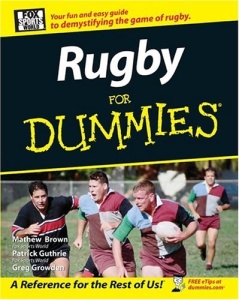 A team normally consists of 15 players, sometimes of 14, but often of 16. Here follows a short description of the different playing positions:
A team normally consists of 15 players, sometimes of 14, but often of 16. Here follows a short description of the different playing positions:
PROPS:
No’s 1 & 3. These guys are more or less as tall as they are broad, without necks, and very strong. They are supposed to push in the scrums. Previously it was not essential for them to touch a rugby ball, and there are quite a number of cases known of props who have completed successfull international careers without ever touching the ball. Nowadays it is required of them to handle like flyhalves and run like centers, which results in them being hopeless in the scrums.
HOOKER:
No 2. Yes, I know the name is a bit silly, but believe me, it becomes these guys. He is slightly smaller than a prop, but twice as aggressive. They throw the ball in at a lineout, and used to have a quick foot for hooking the ball in the scrum. These days they are the same size as props (to compensate for the deficiencies of the latter), which means they disrupt the balance in the scrum and struggle to find their jumpers in the lineout. The result is that they are highly frustated, and tends to give away penalties. Fortunately they don’t have to hook the ball in the scrums anymore, since it is put in underneath the feet of the locks anyway.
LOCKS:
No’s 4 & 5. As broad as props, but twice as tall. Good natured giants that could jump high in lineouts, and used to be kind to scrum halves. Nowadays they are built like high jumpers, with the difference being they can’t jump. It’s not really necessary, because they are lifted by teammates now. Their main purpose now is to loiter on the wings from where they score tries.
FLANKFORWARDS:
No’s 6 & 7, and EIGHTHMAN No 8. Collectively known as LOOSEFORWARDS, for they have a tendency to let flyhalves loose their nerve, and they also knock your teeth loose. I recommend you try and stay out of the way of these guys.
SCRUMHALF:
No 9. The smallest chap on the field, about half the length of a prop (hence the name), one eigth his width, but twice as aggressive as a hooker. Talks a lot, especially to the referee. Previously they could pass the ball in a straight line across the width of a rugby field, but since they are now the size of looseforwards, they find it difficult to pass a ball further than 2 metres. They therefore prefer to kick, or run into forwards, which necessitates that they should be even bigger.
FLYHALF:
No 10. The ballerinas of rugby, who could slip through the smallest of gaps, and let the opposition confused in one place with their illusiveness. They used to be the generals on the field who dictated play, and could kick a ball the whole length of a rugby field, with both feet. Nowadays they look like old time locks, the idea being that they bulldoze into the opposition, who unfortunately also look like old time locks.
CENTRES:
No’s 12 & 13. Two variations, one being the playmaker, who, with quick hands and feet, caught the opposition asleep, and put their outside players into gaps to score tries. The other one was a man with an incredible acceleration, that could make a 90 degree change of direction at full pace. These days they both look like old time props, and their duty is to enforce a ruck in the middle of the field.
WINGS:
No’s 11 & 14. As the name indicate, guys that could fly down the touch line. Racehorses. Their hands used to be somewhat suspect, but with ball in hand they could beat the opposition with sheer pace. They are considerably slower nowadays, but very reliable under the high ball, which enables them to assist the fullback. It is not required of them to score tries anymore – this is done by locks after the centres enforce a ruck in the middle of the field.
FULLBACK:
No 15. The guy in the last outpost. Calm, collected, reliable under the high ball, with a solid defence. Nowadays an absolute risk under the high ball, with suspect defence, but the wings make up for this. Now extremely quick, with all the properties of old time flyhalves, centres and wings in one person. Indeed the most exciting player on attack of the modern era.
NOTE:
In certain countries you will hear terms like ‘1st 5’ and ‘2nd 5’. It comes from ‘1st 5/8’ and ‘2nd 5/8’, and refers to the flyhalf and inside centre respectively. I recommend you ignore these terms, because they were thought up by someone without any clue of fractions. We all know there are only 7 players in the backline, so the ‘eigth’ is meaningless. Add to that the fact that in a set of fractions there can only be one 5/8, the ‘2nd’ becomes even more ridiculous. If you ask me, these were thought up by people without the faintest idea of counting, never mind fractions.